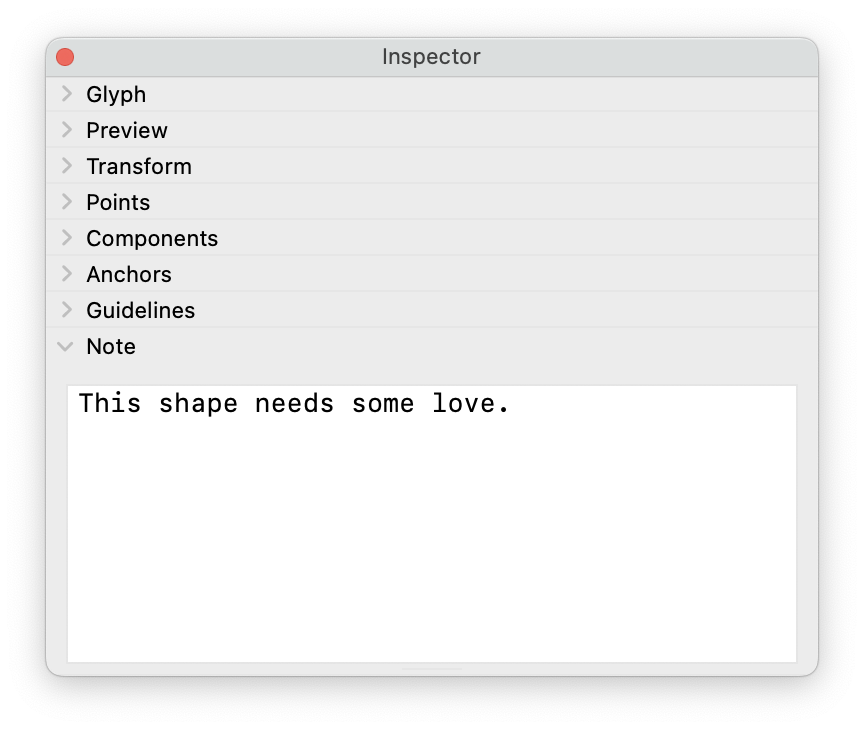Inspector ↩
The features and applications of the Inspector panel.
The Inpector panel is a floating panel which gives access to several kinds of data in the current glyph. The current glyph can be a glyph in the Glyph Editor or a selected glyph in the Font Overview.
To open the Inspector, choose Windows > Inspector from the main application menu, or use the keyboard shortcut ⌘ + I.
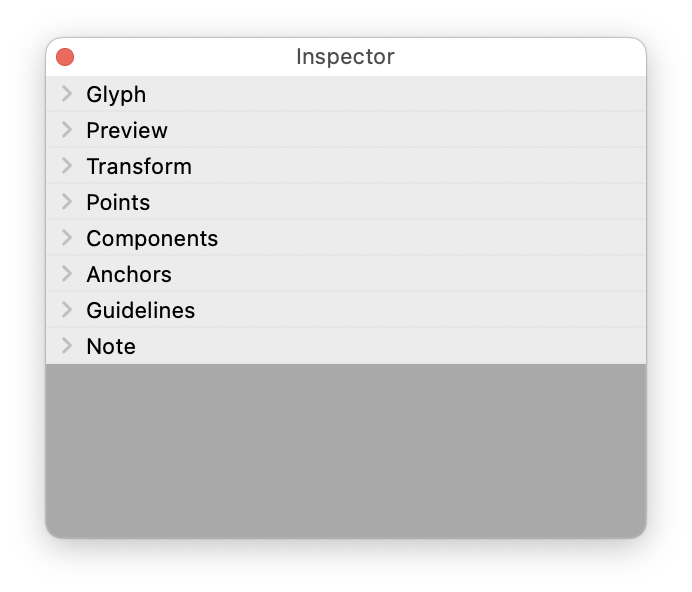
Each section of the Inspector can be collapsed or expanded by clicking on its title. Some sections can be resized.
Glyph
The Glyph section allows you to view and edit basic attributes of the current glyph.
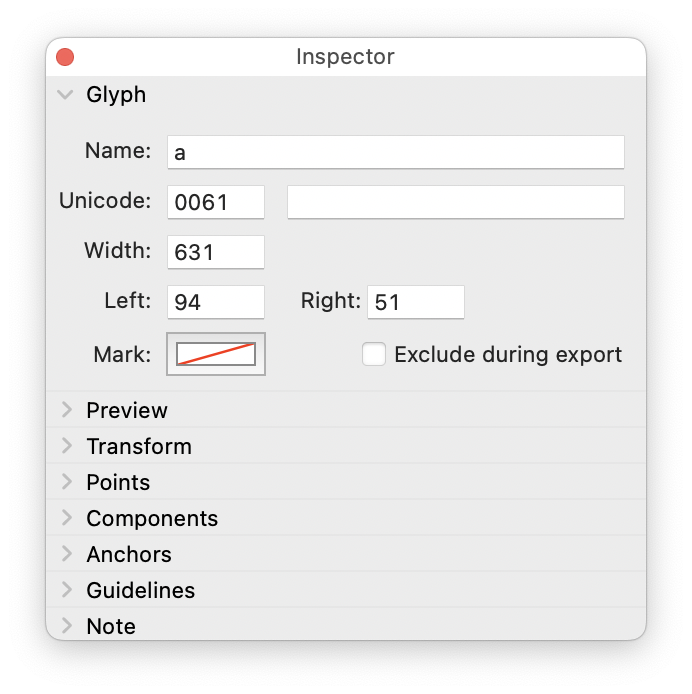
Attributes
| option | description |
|---|---|
| Name | The name of the current glyph. |
| Unicode | The unicode(s) of the current glyph. |
| Width | The advance width of the current glyph. |
| Left | The left margin of the current glyph. |
| Right | The right margin of the current glyph. |
| Mark | The mark color of the current glyph. |
| Exclude during export | A flag indicating if the glyph should be skipped when generating fonts |
Editing glyph names
When a glyph name is edited, a sheet appears in the font window with options to:
- rename all references to this glyph in components, groups and kerning
- set the unicode value automatically based on the glyph name
- rename the same glyph in other layers
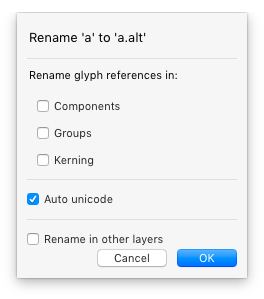
Glyph names which already exist in the font are not allowed when renaming glyphs.
Editing unicode values
When the unicode value is edited, a sheet appears in the font window with options to:
- set the glyph name automatically
- if the glyph name is changed, rename all references to this glyph in components, groups and kerning
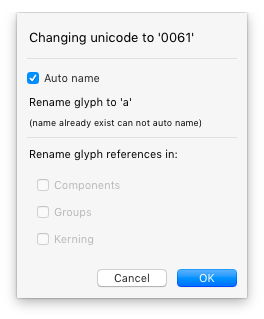
Preview
The Preview section shows a simple live preview of the current glyph.
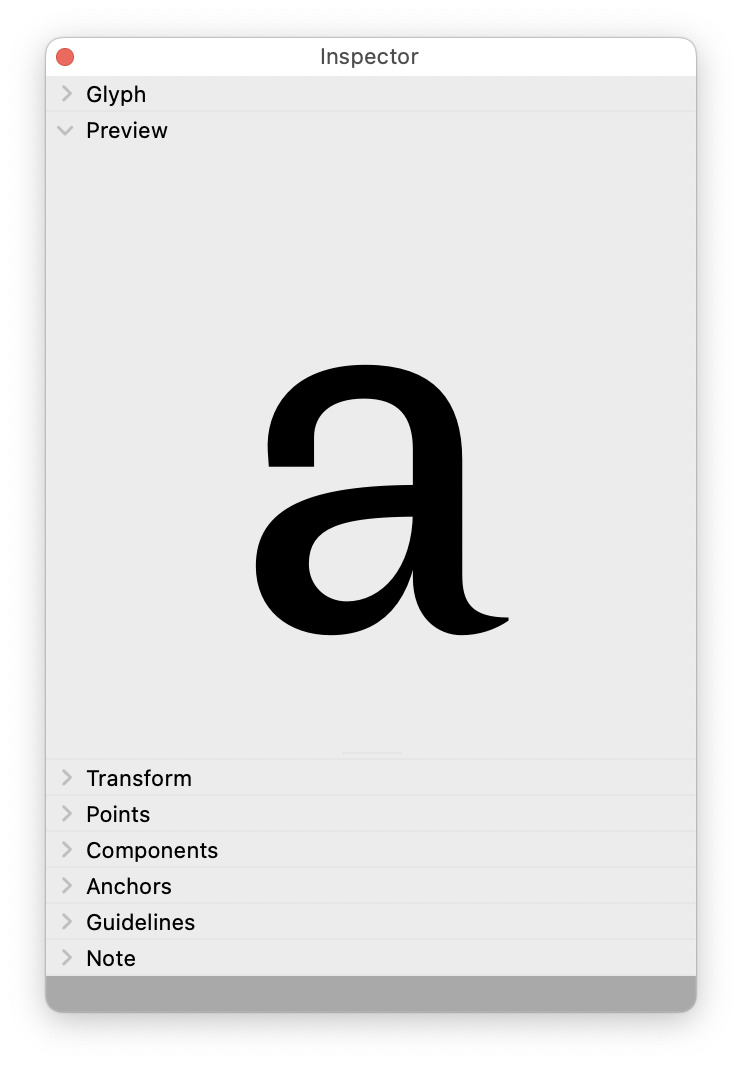
Transform
The Transform section offers several tools to apply transformations to one or more glyphs. The Move, Scale, Rotate, Skew, and Snap may have multiple scopes:
| condition | result |
|---|---|
| The glyph editor is the first responder and there is a selection of one or more elements (contours, anchors...) | the selection is affected by the transformation |
| The glyph editor is the first responder with no selection | The entire glyph is affected by the transformation |
| The font window is the first responder and one or more glyphs are selected | All the glyphs in the selection are affected by the transformation |
Holding down ⌥ while clicking the skew or rotate button will inverse the transformation.
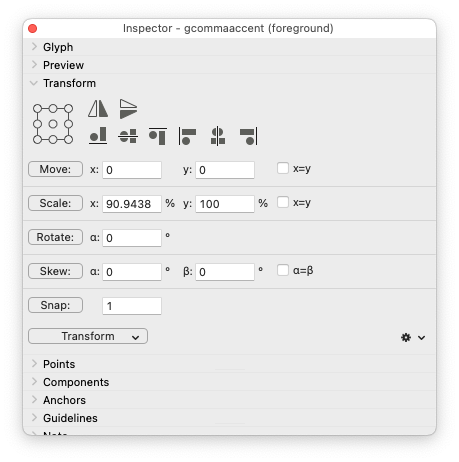
Alignment options
Use the icons at the top to define an origin point for the transformations, and to flip and align shapes.
| option | description |
|---|---|
 |
Select the origin point for the transformation. If no point is selected (0,0) will be used as origin. |
 |
Mirror horizontally. |
 |
Mirror vertically. |
 |
Align selected objects to the bottom. |
 |
Center selected objects vertically. |
 |
Align selected objects to the top. |
 |
Align selected objects to the left. |
 |
Center selected objects horizontally. |
 |
Align selected objects to the right. |
Transformations
Set the individual transformation settings to define a transformation matrix.
| option | description |
|---|---|
| Move | Move selected objects by (x,y) values. Optionally equalize x and y. |
| Scale | Scale selected objects according to (x,y) percentage values. Optionally equalize x and y. |
| Rotate | Rotate selected objects by an angle (in degrees). |
| Skew | Skew selected objects by angles α,β. Optionally equalize α and β. |
| Snap | Snap selected objects to a grid. |
Transform options
The Transform button opens a popup menu with options to control the scope of the transformation within the font.
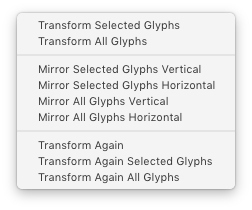
| option | description |
|---|---|
| Transform | Apply all transformations to the current glyph. The transformation can be a combination of move, scale, skew and snap transformations. |
| Transform Selected Glyphs | Apply all transformations to the selected glyphs in the Font Overview. |
| Transform All Glyphs | Apply all transformations to all glyphs in the font. |
| Mirror Selected Glyphs Vertical | Mirror all selected glyphs vertically. |
| Mirror Selected Glyphs Horizontal | Mirror all selected glyphs horizontally. |
| Mirror All Glyphs Vertical | Mirror all glyphs vertically. |
| Mirror All Glyphs Horizontal | Mirror all glyphs horizontally. |
| Transform Again | Apply the same transformation again on the current glyph. This can be handy if the transformation values were set by a Transform action in the Glyph View. |
| Transform Again Selected Glyphs | Apply the same transformation again on the selected glyphs. |
| Transform Again All Glyphs | Apply the same transformation again on all glyphs in the font. |
Transform scope
The gear icon opens a second popup menu with options to control the scope of the transformation within each glyph.
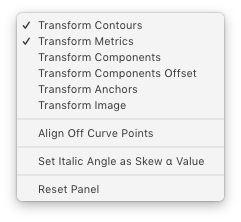
| option | description |
|---|---|
| Transform Contours | Apply transformations to contours. |
| Transform Metrics | Apply transformation to metrics. |
| Transform Components | Apply transformation to components. |
| Transform Anchors | Apply transformation to anchors. |
| Transform Image | Apply transformation to image. |
| Align Off Curve Points | Apply alignment to off-curve points. |
| Set Italic Angle as Skew α Value | Set the skew angle as the font’s Italic Angle. |
| Reset Panel | Reset the panel to default settings. |
- Pressing ⌥ will invert skew and rotate.
Points
The Points section shows a list of all contours and points in the current glyph.
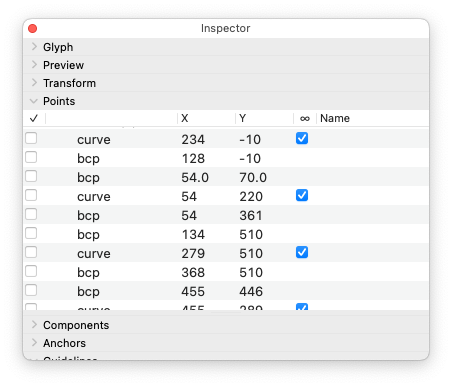
Attributes
| option | description |
|---|---|
| ✔ | A flag indicating if the contour or point is selected. |
| contours | A list of contours. Each contour is a collapsible list of points. |
| X / Y | The position of each point. |
| smoothness |
A flag indicating if the point is smooth or unsmooth. |
| name |
A name for the point (optional). Must not be unique. |
Contextual menu
Right-click in the list to open a contextual menu with options to select and delete points.
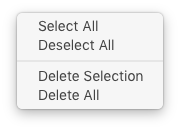
Components
The Components section shows a list of all components in the current glyph.
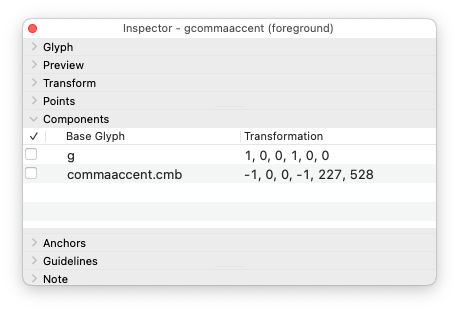
Double-click on any value to edit it.
Attributes
| option | description |
|---|---|
| ✔︎ | A flag indicating if the component is selected. |
| Base Glyph | The glyph referenced by the component. |
| Transformation | The component’s transformation matrix representing its translation, scale, rotation and skew settings. |
Contextual menu
Right-click in the list to open a contextual menu with options to select and delete components.

Anchors
The Anchors section shows a list of all anchors in the current glyph.
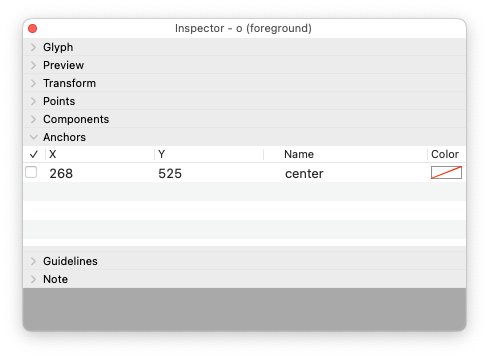
Double-click any value to edit it.
Attributes
| option | description |
|---|---|
| ✔ | A flag indicating if the anchor is selected. |
| X / Y | The position of the anchor. |
| Name | The name of the anchor. |
| Color | The color of the anchor. (optional) |
Contextual menu
Right-click in the list to open a contextual menu with options to select and delete anchors.

Guidelines
The Guidelines section shows a list of all guidelines available in the current glyph, including both font-level (global) and glyph-level (local) guidelines.
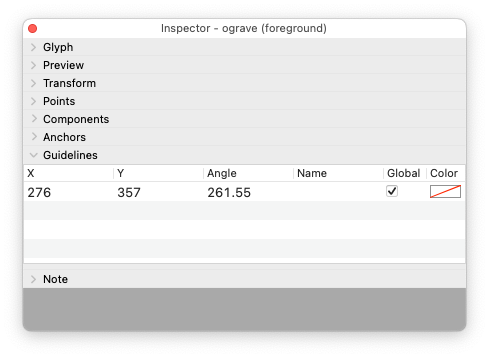
Click and hold to edit any value. Double-click on the color cell to edit the color.
Attributes
| option | description |
|---|---|
| X / Y | The guideline’s origin position. |
| Angle | The angle of the guideline in degrees. |
| Name | The name of the guideline. (optional) |
| Global |
A flag indicating if the guideline is global (font-level) or local (glyph-level). Click on the checkbox to make a local guideline global, and vice versa. |
| Color | The color of the guideline. (optional) |
Note
The Note section contains a simple text box for adding an optional note to the current glyph. This note is stored in the UFO only and does not make it into compiled fonts.
